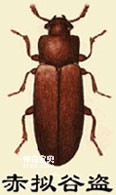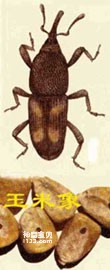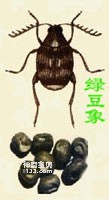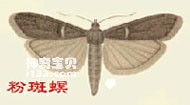Generally, households stock grains such as rice, flour, and beans, as well as plant foods such as peanuts, lotus seeds, red sesame seeds, and day lilies, and animal foods such as dried fish, ham, bacon, and dried shrimps. The troublesome thing is that these foods are often attacked by borers. The reason for this is that some borers were hidden before buying, and some were improperly stored after buying, allowing borers to take advantage of them. Common borers are introduced to readers here.
(1) Mealworm. Northerners love to eat noodles and have flour at home. Most of the beetles that often appear in flour are Tribolium castaneum. They are larger than rice beetles, with reddish-brown bodies. The adults have a square back. There are usually two types: Tribolium castaneum and hybrid Tribolium castaneum. Like the rice bug, the castaneum also likes to hide in corners. When the temperature rises to 28-30°C, they reproduce in large numbers, and each female can lay 1,000 eggs. Therefore, when you see them in flour, there are already a lot of them, which will accelerate the mildew of the flour and make it inedible. In addition, Tribolium castaneum can also appear in ginseng supplements, rice, corn, koji and other items, which will affect the consumption of these foods.

(2) Rice bug. Southerners mainly eat rice. Due to the high temperature in the south, it is easy for insects to develop. Rice at home During the peak summer season of July and August every year, rice borers the size of sesame grains often appear in the rice vat at home. If you look closely at these rice borers, you can see that the bodies of the insects are hard, cylindrical, and brownish-red. It's even more interesting when you look at it under a magnifying glass. It has a beak in front of its head that is exactly like an elephant's trunk. Therefore, it is also called a weevil. There are two types of weevils in rice weevils: corn weevils and rice weevils. These two insects like to hide in corners. Therefore, it is generally not easy to detect it on the surface of rice. Their adults have the ability to pretend to be dead and remain motionless when touched. Adult insects have a wide range of food habits, including cereals, potatoes, dried fruits, medicinal materials, etc. Their larvae are milky white, soft, and have fat bodies. They like to eat rice grains. The rice grains that float on the water after being eaten by us when we pour rice are eaten by them.

(3) Bean bugs. Such common species are also beetles. The adults are often gray-black in color, while the larvae are white, plump and soft and are hidden inside the beans. Generally, the borers that appear in broad beans are broad bean weevils; the borers that appear in red beans and mung beans are mostly mung bean weevils. Although bean weevils and weevils look similar, they are in different families. Bean weevils form a family of their own, called Bean Weevils. Their antennae are ctate-shaped, while weevils' antennae are knee-shaped. The reason why borers appear on beans at home is mostly because these pests have already taken advantage of the opportunity in the bean fields to burrow into the pods and carry them into the house. For example, the broad bean weevil spends the winter hiding as adults in stored broad beans or in cracks in the corners of warehouses. They fly out when the broad beans bloom the next year and lay eggs on the pods when the broad beans begin to form pods. When the broad beans are harvested, the larvae are already lurking in the pods. Inside the bean. All beans damaged by them are very stiff. In severe cases, there are several worms inside a bean, and the beans are often eaten away and become inedible.

(4) Plant-based non-staple food storage pests. Pests of stored foods such as yellow flowers, peanuts, and sesame are mostly small moths. Two common species: Indian meal borer and mealypot moth. The former has obvious reddish-brown spots on its wings, while the latter has no reddish-brown spots. If you see small moths flying around your home in summer, you should quickly check whether the stored dried foods are moth-infested and deal with them promptly. Also check out things like dates, fungus, peppers, and even chocolate.

Stored non-staple foods such as black fungus, lotus seeds, and red date bugs are often harmed by saw millet beetles and bookworms. The sawmillet beetle is a small beetle, about the size of a sesame seed. Its back is serrated on both sides and its body is flat and easy to bore. The adults are lively, crawl quickly, live for more than 3 years, lay large quantities of eggs, the egg-laying period lasts for more than 2 months, and the larvae develop quickly. So once it happens, the number is often very large. In addition, saw millet beetle can adapt to high and low temperatures and is highly resistant. It can even harm biscuits, moon cakes, starch, ginseng, angelica, and chocolate.
(5) Pests in stored meat and non-staple food. If you find small black flies on ham or bacon, they must be caseflies. The adults are very lively and like light; the larvae, on the contrary, prefer light and live in groups to feed. In addition to harming ham, bacon, bacon, bacon, smoked fish, etc., caseflies often appear in human feces and corpses. Therefore, in addition to direct harm, it can also transmit diseases.

(6) Sugar-eating bugs. There are worms in sugar, mainly common sugar mites. Although mites are not insects, they are closely related to insects and have similar harmful habits, so they are both studied in entomology. The body of the mite is very tiny. The length of the adult mite is only 350-560 microns. It is difficult to see with the naked eye. Its true appearance can only be seen under a microscope. Adult mites have 4 pairs of legs and move with sudden beating steps, and their movements are rapid and irregular. When the temperature is 20-23°C and the sugar is slightly damp, the reproduction rate of this insect will be greatly increased. Sugar mites can cause asthma in humans. Therefore, sugar cannot be stored for too long. If it takes a long time and the sugar gets damp, it is best to boil the sugar with water and filter the sugar water with gauze before eating.
(7) Tips for preventing and controlling insect infestations. Generally speaking, the main approach to dealing with edible storage borers is prevention. Keeping food dry and clean is the most critical. Therefore, how to keep edible stored products well, so that they are not damp, do not deteriorate, and lack conditions for moths to breed is the basis of prevention and control. The following is an introduction to several methods of preventing and controlling borers at home for readers to try.
① Stimulation method. Before storing rice, clean the container and its surroundings. If rice bugs are found in the rice, you can put ginger, pepper or garlic in the rice container. Its pungent smell can repel insect invasion, and the allicin released by pepper and garlic can also It has the effect of controlling insects.
②High temperature method. In rural areas, there is usually a large amount of grain stored at home. When it is found that there are about 2 worms/kg in the grain, it is necessary to control the worms. You can pour the grain on the cement floor and expose it to the sun for 4-5 hours. Turn it every half hour to raise the grain temperature to about 48°C. After 3 p.m., collect the grain and pack it. The insecticidal effect can reach more than 90%.
③Sealing method. Noodles and rice noodles should be stored in intact plastic bags and tightly sealed. If there are already pests, they can be screened out before bagging. Long-term lack of oxygen in the bag will also kill the insects. As for small amounts of cereals such as adzuki beans, mung beans, peanuts, and sesame seeds, they can be placed in bags and sealed after being exposed to sunlight and cooled, and then double-sealed in buckets or cans. Regarding meat and animal non-staple foods, fresh foods are not susceptible to insect damage, while those that have been stored for a long time and are unpackaged are prone to insect infestation in warm seasons. Therefore, if stored for a long time, it must be tightly wrapped and refrigerated. As for fungus, lotus seeds and other plant-based non-staple foods, cleanliness, dryness and mildew prevention are the most effective measures to protect them from pests. In addition, food can also be stored in containers with better sealing properties, such as plastic boxes.
④ Boiling water immersion method. This method is very effective for broad bean weevils and is easy to operate. On a sunny day, boil the water, immerse the broad beans (2.5-5 kg) in the boiling water for 30-40 seconds, take them out and dry them in the sun. This can kill the insects inside the beans without affecting the germination rate of broad beans.
⑥Refrigerator freezing method. Small packages of food or grain can be placed in the refrigerator for a few days to freeze the existing insect eggs inside. If it is found that food is infested by insects, the affected parts should be dried quickly or stored in a low temperature such as a refrigerator; if the damage is severe and the amount is large, fumigation should be done.
animal tags: borers mealworms riceworms pests sugarworms
We created this article in conjunction with AI technology, then made sure it was fact-checked and edited by a Animals Top editor.